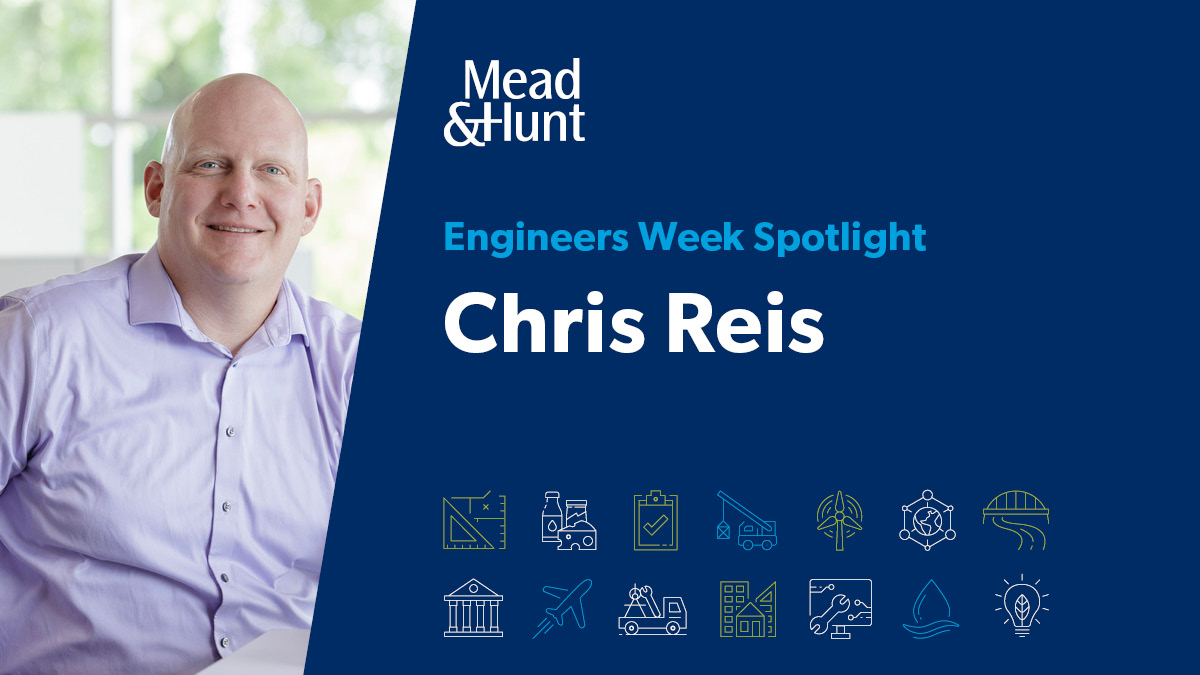This Engineers Week we are sharing the stories of our engineers who challenge the traditional mold, who faced obstacles, and who are inspiring the next generation of problem-solvers.
Today, meet Chris Reis, National Practice Leader for Aviation Engineering at Mead & Hunt. As a kid he enjoyed drawing and playing with Legos and wanted to become an architect, but later he found that engineering was the perfect marriage of drawing and building. Now, as a professional engineer, he is working with students from middle school to college and introducing them to the field of aviation engineering.
When did you first become interested in engineering?
I always loved drawing, building, and playing with Legos. In elementary school we did a career day, and I saw a job description for a mechanical engineer. It seemed interesting because it combined the building and the drawing, and that was a big part of why I got into engineering – I enjoyed the actual hand drawing with the T-square, triangles, and everything else.
What was your path to becoming an engineer?
In high school, I took a lot of technical classes – math, woodshop, and drafting. I then went to UW-Platteville and started off as a mechanical engineer. I started as a summer intern at an engineering firm doing CAD work and more civil-related work. It’s funny because while I was there, I actually met people from Mead & Hunt, and then after three summers interning, I joined Mead & Hunt in 2001. My first project was on the Air National Guard base near where I grew up, and I’ve worked in aviation engineering ever since.
What is your favorite part of being an engineer?
In November last year, I became the national practice leader for aviation engineering. My role is to support, coach, mentor and be a resource for our aviation engineering team nationwide. I’m really enjoying getting to know the team, figuring out how I can improve processes, listening to them to see what their needs are and addressing them. I get to meet with everyone in aviation engineering and have discussions that help me understand their challenges and obstacles. Sometimes in those calls, I’m able to share something with them that solves their problem, and it’s really rewarding.
What motivates you at work and in your personal life?
My wife and I like to take on challenges. I’ve done two marathons and try to do at least one half-marathon a year. We also have two young boys, so they motivate me every day. I love finding ways to give back, like through coaching. I’m always just looking for those challenges and ways to stay busy.
Tell us about your STEM outreach efforts.
I try to serve the community through STEM outreach whenever I can. I always go back to UW-Platteville and guest lecture or speak in classes to open students’ eyes to opportunities in aviation. I’m also involved with the university’s women in STEM program. Another organization I’ve been able to work with is the Boy Scouts’ Exploring program. It’s focused on aviation, but it allows me to share the engineering side of things with the kids as well.
Why do you think engineering is for everyone?
I think engineering is for everyone because if you have an interest in improving things and making things better than when you got them, you can do that as an engineer, no matter your skillset. The effort in equals the effort out. I’ve known a lot of people that have had an easy path to engineering and a lot of people that have had a very hard and long path. But in the end, they became engineers because they all wanted to leave the world better than they found it.
Whether it’s providing clean water, building a road, generating green energy, or designing a building, engineers create a better world for all of us! Their job is to tackle big challenges with big solutions, and they do their best work when they can see problems from every point of view.
That’s why we believe engineering is for everyone, and we’re thankful for professionals like Chris who help students see the opportunities in engineering!



